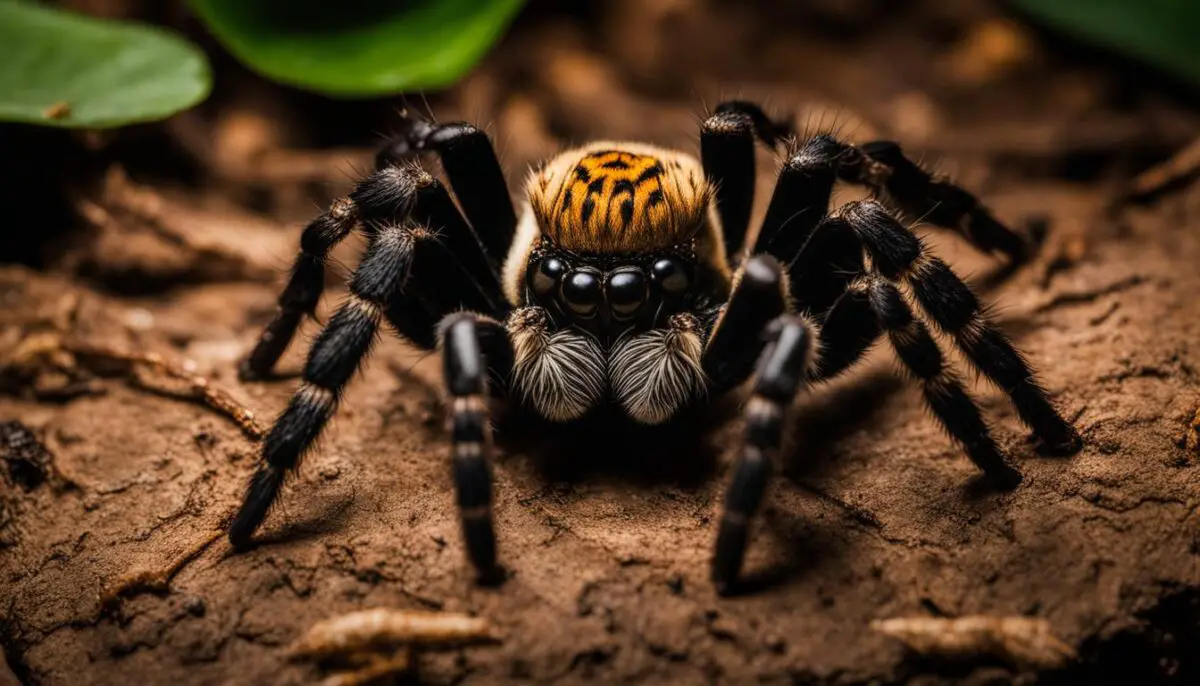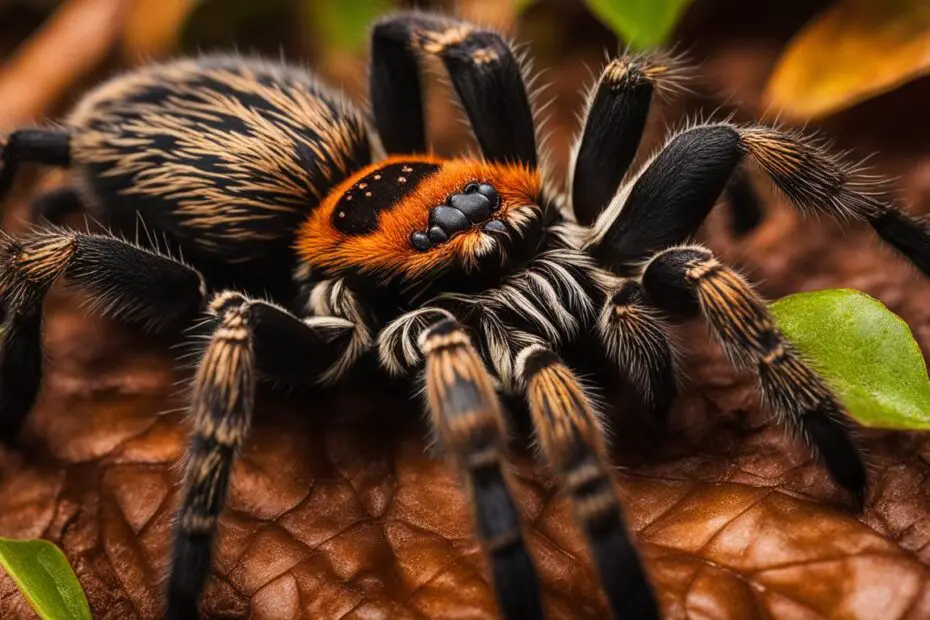The world of tarantulas is fascinating and diverse, but did you know that some species are in danger of extinction? In this guide, we will explore the endangered tarantulas and shed light on their conservation status. From the tarantulas native to India and Sri Lanka to those found in the United States and Brazil, we will uncover the unique challenges they face and the efforts being made to protect them.
Key Takeaways:
- 11 tarantula species from India and Sri Lanka are being considered for Endangered Species Act protection.
- The endangered tarantulas in India include Poecilotheria formosa, Poecilotheria metallica, and Poecilotheria striata.
- The endangered tarantulas in Sri Lanka include Poecilotheria ornate, Poecilotheria pederseni, and Poecilotheria subfusca.
- The spruce-fir moss spider is an endangered tarantula species found in Great Smoky Mountains National Park.
- Nine new species of arboreal tarantulas have been discovered in Central and Eastern Brazil.
Which Tarantulas are Endangered
Endangered Tarantula Species Native to India
The Indian subcontinent is home to several species of tarantulas that are at risk of extinction. These magnificent creatures, known for their vibrant colors and intricate patterns, face numerous threats to their survival. Conservation efforts are underway to protect these endangered arachnids and ensure their continued presence in the wild. which tarantulas are endangered
Among the tarantula species at risk in India are Poecilotheria formosa, Poecilotheria hanumavilasumica, Poecilotheria metallica, Poecilotheria miranda, Poecilotheria rufilata, and Poecilotheria striata. These tree-dwelling tarantulas are found in the tropical and subtropical forests of the region, where they rely on their exceptional hunting skills to capture prey. Unlike other spiders, they do not use webs to trap their victims, making them particularly fascinating and unique.
Conservation Status of Tarantulas
The conservation status of these tarantula species is of great concern. Poecilotheria formosa, Poecilotheria rufilata, and Poecilotheria striata are classified as vulnerable, while Poecilotheria hanumavilasumica, Poecilotheria metallica, and Poecilotheria miranda are classified as near threatened. These designations highlight the urgent need for conservation measures to protect these extraordinary creatures from further decline.
| Species | Conservation Status |
|---|---|
| Poecilotheria formosa | Vulnerable |
| Poecilotheria hanumavilasumica | Near Threatened |
| Poecilotheria metallica | Near Threatened |
| Poecilotheria miranda | Near Threatened |
| Poecilotheria rufilata | Vulnerable |
| Poecilotheria striata | Vulnerable |
Efforts are being made to raise awareness about the plight of these endangered tarantulas and promote sustainable practices to safeguard their habitats. By protecting these remarkable species, we can contribute to the preservation of our planet’s biodiversity and ensure the continued existence of these mesmerizing creatures for future generations. endangered spider species
Endangered Tarantula Species Native to Sri Lanka
The island nation of Sri Lanka is home to several species of tarantulas that are facing the threat of extinction. These tarantulas, including the Poecilotheria fasciata, Poecilotheria ornate, Poecilotheria pederseni, Poecilotheria smithi, and Poecilotheria subfusca, are classified as protected tarantula species due to their limited populations and vulnerable conservation status.
These Sri Lankan tarantulas face numerous challenges, with some species categorized as critically endangered, vulnerable, or near threatened. Their habitats are under immense pressure from human activities, including deforestation and habitat destruction. Conservation efforts are crucial in preserving these endangered spider varieties.
A key aspect of tarantula conservation in Sri Lanka involves habitat restoration and protection. The preservation of their natural habitats is vital for the survival of these species. Additionally, efforts are being made to raise awareness about the importance of conserving these unique arachnids and to regulate the pet trade to prevent further threats to their populations. conservation status of tarantulas
Conservation Efforts for Tarantulas in Sri Lanka
Several organizations and initiatives are dedicated to conserving and protecting the endangered tarantula species in Sri Lanka. These efforts focus on scientific research, habitat restoration, captive breeding programs, and education. By collaborating with local communities, conservationists aim to ensure the long-term survival and recovery of these vulnerable tarantulas.

| Tarantula Species | Conservation Status |
|---|---|
| Poecilotheria fasciata | Critically Endangered |
| Poecilotheria ornate | Vulnerable |
| Poecilotheria pederseni | Near Threatened |
| Poecilotheria smithi | Vulnerable |
| Poecilotheria subfusca | Vulnerable |
Endangered Tarantulas in Great Smoky Mountains National Park
The Great Smoky Mountains National Park is home to a unique and endangered tarantula species known as the spruce-fir moss spider. Considered the world’s smallest tarantula, this species faces numerous threats to its survival. With a habitat primarily located in the spruce-fir forest ecosystems of the park, these tarantulas are particularly susceptible to the effects of invasive insects, climate change, and habitat alteration. conservation efforts for tarantulas
The U.S. Fish and Wildlife Service recognized the critical situation faced by the spruce-fir moss spider and added it to the federal endangered species list in 1995. Since then, efforts have been underway to protect the spider’s habitat and ensure its long-term survival. One of the key challenges in conservation is combatting the decline of the spider’s preferred habitat due to the encroachment of invasive insects and the alteration of its spruce-fir forest ecosystem.
Conservation Efforts in Great Smoky Mountains National Park
To address these threats, conservation programs in the Great Smoky Mountains National Park have been initiated. These programs include chemical treatments of Fraser firs, the primary food source of the spruce-fir moss spider, to control the population of invasive insects. Additionally, habitat restoration projects are being implemented to promote the regeneration of the spruce-fir forest and create a more favorable environment for the tarantula. tarantula conservation programs
| Conservation Measures | Impact |
|---|---|
| Chemical treatments of Fraser firs | Controlling invasive insects and protecting the spider’s food source |
| Habitat restoration projects | Promoting the regeneration of the spruce-fir forest and creating a favorable environment for the tarantula |
These conservation efforts aim to halt the decline of the spruce-fir moss spider population and ensure the long-term viability of this endangered tarantula species. By preserving its habitat and addressing the key threats it faces, there is hope for the survival of this unique spider in the Great Smoky Mountains National Park.
Arboreal Tarantulas in Central and Eastern Brazil
Nestled amidst the lush biodiversity of Central and Eastern Brazil, a treasure trove of nine newly discovered arboreal tarantula species awaits exploration. These fascinating creatures, with their lighter builds, thinner bodies, and longer legs, have adapted to thrive in the dense canopies of the Amazon rainforest and other threatened habitats like the Brazilian Atlantic Rainforest and the Cerrado.
These arboreal tarantulas contribute to the rich tapestry of biodiversity in these regions, showcasing the intricate web of life in these fragile ecosystems. By preying on small insects like mites and springtails, they help regulate populations and maintain the delicate balance of nature.

Conservation Programs for Endangered Tarantulas
Protecting and conserving endangered tarantulas is a crucial priority for various dedicated conservation programs and organizations. These initiatives aim to safeguard the habitats of these unique arachnids, promote captive breeding, educate the public, and conduct vital research to ensure their long-term survival.
The U.S. Fish and Wildlife Service’s Endangered Species Act is a prominent program that plays a significant role in tarantula conservation efforts. This legislation provides federal protection to endangered species, including tarantulas, and helps to regulate activities that may harm their populations or habitats.
“Conservation programs for endangered tarantulas focus on habitat restoration, captive breeding, public education, and research.”
International collaborations also contribute to the conservation of endangered tarantulas. These partnerships involve sharing knowledge, resources, and best practices to maximize the impact of conservation efforts on a global scale. By joining forces, organizations can work together to implement effective strategies and increase the chances of preserving these fascinating creatures.
| Conservation Programs for Endangered Tarantulas | Focus Areas |
|---|---|
| U.S. Fish and Wildlife Service’s Endangered Species Act | Federal protection, habitat regulation |
| International Collaborations | Sharing knowledge and resources |
| Tarantula Breeders and Conservation Organizations | Captive breeding and public education |
| Research Institutes and Universities | Scientific studies and monitoring |
Tarantula breeders and conservation organizations also contribute significantly to the conservation of endangered tarantulas. These groups engage in captive breeding programs, ensuring the genetic diversity and population sustainability of these species. They also play a vital role in educating the public about the importance of tarantulas and dispelling misconceptions surrounding them.
Research institutes and universities carry out scientific studies and monitoring projects to gather essential data on tarantulas’ ecology, behavior, and conservation status. These efforts help inform conservation strategies and provide valuable insights into the management and protection of these remarkable arachnids.
The Ecological Role of Tarantulas as Predators
As fascinating creatures, tarantulas not only captivate our curiosity but also play a crucial role in maintaining the balance of ecosystems. These large and formidable arachnids serve as top predators, contributing to the regulation of insect populations in their habitats. Tarantulas are known to prey on various small insects such as mites and springtails, helping to control their numbers and prevent population outbreaks.
By actively hunting and consuming these smaller insects, tarantulas contribute to the overall health and stability of their ecosystems. They help prevent the overconsumption of plant matter by herbivorous insects and ensure the availability of resources for other organisms within the food chain. Additionally, their predatory presence can help limit the spread of disease-carrying insects, benefiting not only the ecological balance but also human and animal populations in their respective habitats.
“Tarantulas are essential for maintaining the biodiversity and functioning of natural habitats. Their role as top predators in ecosystems contributes to the overall health and balance of populations.”
Furthermore, the burrows created by tarantulas have additional ecological significance. These burrows serve as shelters for other small organisms including insects, reptiles, and amphibians. These microhabitats provide protection from predators, harsh weather conditions, and can even contribute to the nutrient cycling within the ecosystem. The presence of tarantulas in an ecosystem helps create diverse and interconnected microcosms within the larger habitat, promoting biodiversity and supporting a healthy ecological network.
The Role of Tarantulas in Ecosystems:
- Regulate insect populations by preying on small insects like mites and springtails
- Contribute to the overall health and stability of ecosystems
- Help prevent overconsumption of plant matter by herbivorous insects
- Limit the spread of disease-carrying insects
- Create microhabitats within their burrows, supporting biodiversity

| Tarantula Species | Prey | Habitat |
|---|---|---|
| Poecilotheria formosa | Small insects, mites | Wooded tropical and subtropical forests |
| Poecilotheria hanumavilasumica | Small insects, springtails | Wooded tropical and subtropical forests |
| Poecilotheria metallica | Insects, arthropods | Wooded tropical and subtropical forests |
Table: Tarantula species and their prey and habitats
Future Challenges and Conservation Efforts
The future of endangered tarantula species hinges on addressing the numerous challenges they face and implementing effective conservation efforts. One of the primary challenges is habitat loss due to deforestation and human activities. As more and more natural habitats are destroyed or fragmented, the tarantulas’ ability to find suitable places to live and reproduce diminishes. Protecting and restoring their habitats is crucial for their survival.
Another significant challenge is the international pet trade, which poses a threat to many tarantula species. The demand for exotic pets drives the capture and trafficking of these fascinating creatures, further endangering their populations. Regulating and controlling the pet trade is essential to ensure the sustainability of tarantula populations in the wild.
Climate change also poses a significant threat to tarantulas. As temperatures rise and ecosystems shift, the habitats of these arachnids may become unsuitable for their survival. The effects of climate change on their prey species, such as insects and other invertebrates, can also disrupt the delicate balance of their food sources. Adapting to and mitigating the impacts of climate change is crucial for the long-term survival of these unique creatures.
Collaborative Efforts: Protecting the Future of Tarantula Species
Conservation organizations, governments, and researchers are working together to develop and implement strategies to overcome these challenges. These collaborative efforts involve:
- Establishing protected areas and reserves to conserve tarantula habitats.
- Conducting research to better understand tarantula biology, population dynamics, and their ecological role.
- Engaging in public education and awareness campaigns to promote the importance of tarantula conservation.
- Implementing regulations and policies to control and monitor the pet trade.
- Developing sustainable practices that minimize the impact of human activities on tarantula habitats.
| Challenges in Tarantula Conservation | Conservation Efforts |
|---|---|
| Habitat loss due to deforestation and human activities | Establishing protected areas and reserves to conserve tarantula habitats |
| The international pet trade | Implementing regulations and policies to control and monitor the pet trade |
| Climate change | Developing sustainable practices that minimize the impact of human activities on tarantula habitats |
By addressing these challenges and implementing conservation strategies, we can work toward securing a future for endangered tarantula species. Continued research, monitoring, and collaboration between organizations and governments are crucial for the long-term survival and conservation of these fascinating creatures. Together, we can ensure that tarantulas remain a vital part of our ecosystems for generations to come.

Conclusion
In conclusion, the conservation of endangered tarantulas is of utmost importance in protecting these unique and often misunderstood creatures. The review of their conservation status and potential listing under the Endangered Species Act is a significant step towards their protection.
Endangered tarantulas face numerous threats, including habitat loss, the international pet trade, and climate change. Efforts to conserve their habitats, regulate the pet trade, and increase awareness are crucial for their survival.
Tarantulas play a vital role in ecosystems as top predators, helping to regulate insect populations and maintain the balance and health of natural habitats. By understanding the threats they face and their ecological significance, we can work towards ensuring the long-term viability of endangered tarantula species.
The future of these fascinating creatures depends on effective conservation efforts, including habitat restoration, captive breeding, and sustainable practices. Continued research, monitoring, and collaboration between organizations and governments are essential for their long-term survival and conservation.
FAQ
Which tarantulas are considered endangered?
The U.S. Fish and Wildlife Service is considering extending Endangered Species Act protection to 11 tarantula species native to India and Sri Lanka. The species in India include Poecilotheria formosa, Poecilotheria hanumavilasumica, Poecilotheria metallica, Poecilotheria miranda, Poecilotheria rufilata, and Poecilotheria striata. The species in Sri Lanka include Poecilotheria fasciata, Poecilotheria ornate, Poecilotheria pederseni, Poecilotheria smithi, and Poecilotheria subfusca. Additionally, the spruce-fir moss spider, the world’s smallest tarantula, is an endangered species found in Great Smoky Mountains National Park.
What are the threats to endangered tarantulas?
Endangered tarantulas face threats such as habitat loss due to deforestation and human activities, the international pet trade, and climate change. The destruction of their natural habitats and the demand for exotic pets put these fascinating creatures at risk.
How can tarantulas be protected and conserved?
Several conservation programs and organizations are dedicated to protecting and conserving endangered tarantulas. These initiatives focus on habitat restoration, captive breeding, public education, and research. Programs such as the U.S. Fish and Wildlife Service’s Endangered Species Act and international collaborations aim to ensure the survival and long-term viability of these unique arachnids.
What is the ecological importance of tarantulas?
Tarantulas play a crucial role in ecosystems as top predators. They help regulate insect populations by feeding on small insects like mites and springtails. The presence of tarantulas in an ecosystem contributes to the balance of populations and the overall health of the ecosystem.
What are the future challenges and conservation efforts for tarantulas?
The future of endangered tarantulas depends on effective conservation efforts and addressing the challenges they face. This includes tackling habitat loss, regulating the pet trade, and promoting sustainable practices. Continued research, monitoring, and collaboration between organizations and governments are crucial for the long-term survival and conservation of these fascinating creatures.


I’ll immediately grab your rss feed as I can’t find your email subscription link or e-newsletter service. Do you have any? Please let me know in order that I could subscribe. Thanks.
I like this web blog it’s a master piece! Glad
I observed this ohttps://69v.topn google.Raise your
business